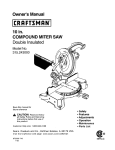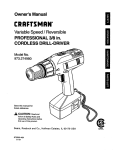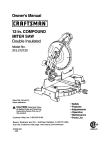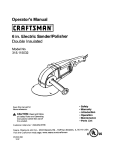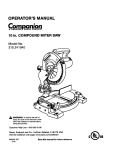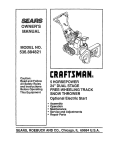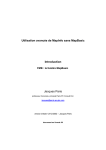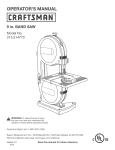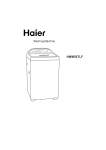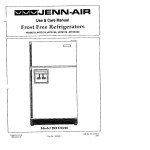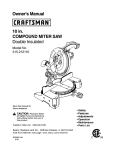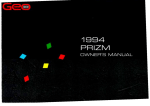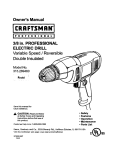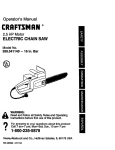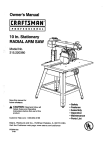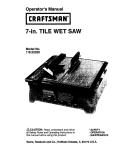Download Craftsman 315.2121O0 Saw User Manual
Transcript
Owner's Manual 10 in. COMPOUND MITER SAW Double Insulated Model No. 315.2121 O0 Save this manual for future reference CAUTION: Read and follow all Safety Rules and Operating Instructions before first use of this product, Customer Help Line: 1-800-932-3188 • • • • • • Safety Features Adjustments Operation Maintenance Parts List Sears, Roebuck and Co., Hoffman Estates, IL 60179 USA Visit the Craftsman web page: www.sears com/craftsman 972000-578 8-98 NRTL/C • Table of Contents ........................................................................................................................................... 2 • Warranty and Introduction.............................................................................................................................. 2 • Rules For Safe Operation ........................................................................................................................... • Glossary ......................................................................................................................................................... 6 • Product Specificationsand Unpacking .......................................................................................................... 7 • Labels............................................................................................................................................................. 8 • Loose Parts and Tools Needed ...................................................................................................................... 9 • Features .................................................................................................................................................. 10-12 • Adjustments............................................................................................................................................. 13-19 • Operation................................................................................................................................................. 20-26 • Maintenance............................................................................................................................................ 27-28 • ExplodedView and Repair Parts List ...................................................................................................... 30-37 • Parts Ordedng / Service ............................................................................................................................... 3-6 38 FULL ONE YEAR WARRANTY If this productfails due to a defect in material or workmanshipwithin one year from the date of purchase, Sears will repair it free of charge. Contact a Sears Service Center for repair. If this productis used for commercial or rental purposes, this warranty applies only for 90 days from the date of purchase. This warranty gives you specificlegal dghts, and you may also have other rightswhich vary from state to state. Sears, Roebuck and Co., Dept. 817WA, Hoffman Estates, IL 60179 Yoursaw has many features for makingcuffing operationsmore pleasant and enjoyable. Safety, performanceand dependability have been giventop pdodty ih the design of this saw making it easy to maintain and operate, ,_ Look for this symbol to point out important Your safety is involved. _IL CAUTION: Carefullyread through this entire owner's manual:beforeusing your new saw. Pay close attention to the Rules For Safe Operation, and all Safety Alert SymbolsincludingDanger, Warning and Caution. If you use your saw properlyand onlyfor what it is intended, you will enjoyyears of safe, reliable service. safety precautions. It means attentionlH _lb WARNING: The operation of any powertool can resultin foreignobjects being thrown into your eyes, which can result in severe eye damage. Before beginningpower tool operation, always wear safety gogglesor safety glasses with side shields and a full face shield when needed. We recommend Wide _sion Safety Mask for use over eyeglasses or standard safety glasses with side shlel(Js,available at Sears Retail Stores.: 2 Thepurposeof safetysymbolsIsto attractyourattention to possible dangers. The safety symbols, and the explanations with them, deserve your careful attention and understanding. The safety warnings do not by themselves eliminate any danger. The Instructions or warnings they give are not substitutes for proper accident prevention measures. SYMBOL & MEANING SAFETY ALERT SYMBOL: Indicates danger, warningor caution. •ey be used in conjunctionwith other symbolsor pictographs. A DANGER: Failure to obey a safety waming will resultin sedous injuryto yourseffor to others. Always follow the safety precautionsto reduce the dsk of tire, electricshock and personalinjury. A WARNING: Failureto obey a safety waming can resultIn sadous injuryto yourseffor to others. Always follow the safety precautionsto reducethe dskof fire, electdc shock and personal injury. & CAUTION: Failureto obey a safety waming may resultIn propertydamage or personal injuryto yourseffor to others. Always follow the safety precautionsto reducethe flsk of fire, electricshock and personal injury. NOTE: Advisesyou of informationor instructionsvital to the operationor maintenanceof the equipment. DOUBLE INSULATION Double insulationis a concept in safety, in electric power tools,which eliminates the need for the usual thrae-wira groundedpower cord. All exposed metal parts are isolated from intemal metal motor componentswith protectinginsulation.Double insulatedtoolsdo not need to be grounded. _k WARNING: Do not attempt to operate this tool until you have read thoroughlyand understand completely all instructions,safety rules, etc. contained in this manual. Failure to complycan result in accidents involvingfire, electdc shock, or serious personal injury. Save owner's manual and review frequently for continuingsafe operation, and instructingothers who may use this tool. IMPORTANT Servicingrequiresextreme care and knowledgeof the system and shouldbe performed only by e qualified sawica technician. For servicewe suggestyou retum the tool to your nearest Sears store for repair.Always use odginalfactory replacement parts when servicing. KEEP THE WORK AREA CLEAN. Clutteredwork areas and work benches invite accidents. DO NOT leave tools or pieces of wood on the saw while it is in operation. • READ ALL INSTRUCTIONS KNOW YOUR POWER TOOL. Read the owner's manual carefully. Learn the saw's applications and limitationsas well as the specific potential hazards related to this tool GUARD AGAINST ELECTRICAL SHOCK BY PREVENTING BODY CONTACT WITH GROUNDED SURFACES. For example; pipes, radiators, ranges, refdgerator enclosures. KEEP GUARDS IN PLACE and in good working order. REMOVE ADJUSTING KEYS AND WRENCHES. Get in the habit of checking to see that hex keys and adjustingwrenches are removed from tool before fuming on saw. DO NOT USE IN DANGEROUS ENVIRONMENTS. Do not usa powertools near gasolineor other flammable liquids,in damp or wet locations, or expose them to rain. Keep the work area well lit. KEEP CHILDREN AND VISITORS AWAY. All visitorsshould wear safety glasses and be kepta safe distancefrom work area. Do not let visitors contact tool or extension cord while operating. • MAKE WORKSHOP CHILD-PROOF with padlocksand master switches,or by removingstarter keys. • DO NOT FORCE THE TOOl- It will do the job better and safer at the rate for which it was designed. • USE THE RIGHT TOOL. Do not force the tool or attachment to do a job it was not designed for. Don't use it for a purposenot intended. RULES FOR SAFE OPERATION (Continued) USE THE PROPER EXTENSION CORD. Make sure your extension cord is in good condition. When using an extension cord, be sure to use one heavy enough to carry the current your productwill draw. An undersizedcord will cause a drop in line voltage resultingin loss of power and overheating.A wire gage size (A,W.G.) of at least 14 is recommendedfor an extension cord 25 feet or less in length. If in doubt,use the next heavier gage. The smaller the gage number,the heavier the cord. function. Check for alignmentof moving pads, bindingof moving part==,breakage of parts, mountingand any other conditions that may affect its operation.A guard or other part that is damaged must be propady repaired or replaced by a qualified service technicianat a Sears store to avoid dsk of personal injury. NEVER LEAVE TOOL RUNNING UNATTENDED. TURN THE POWER OFF. Do not leave tool until it comes to a complete stop. INSPECT EXTENSION CORDS PERIODICALLY and replace if damaged. DRESS PROPERLY. Do not wear loose clothing, gloves, neckties, dngs, bracelets, or other jewelry. They can get caught and drew you into moving parts. Rubber gloves and nonsliptootwear are recommended when workingoutdoors. Ais0 wear protective hair covedng to contain long hair. M RRMLY CLAMP OR BOLT your miter sew to a workbenchor table at approximatelyhip height. M USE ONLY CORRECT BLADES. Do not use blades with incorrectsize holes; Never use blade washers or blade bolts that are defec_ve or incorrect.The maximum blade capacity of your saw is 10 in. KEEP BLADES CLEAN, SHARP AND WITH SUFFICIENT SET. Sharp blades minimize stallingand kickback. ALWAYS WEAR SAFETY GLASSES WITH SIDE SHIELDS. Everyday eyeglasses have only impact-resistantlenses; they are NOT safety glasses. DO NOT REMOVE THE SAW'S BLADE I GUARDS. Never operate the sew with any guard or cover removed. Make sure all guardsare operating propady before each use. PROTECT YOUR LUNGS. Wear a face or dust mask if the cuttingoparetlon is dusty, KEEP HANDS AWAY FROM CUTTING AREA. Keep handsaway from blades. Do not reach underneath work or around or under the blade while blade is rotating. Do not attempt to remove cut matedal when blade is moving. PROTECT YOUR HEARING. Wear headng protectiondudng extended padods of oparetion. SECURE WORK. Use clamps or a vise to hold work when practical. I_ssafer than using your hand and It frees both hands to operete tool. _1= WARNING: DO NOT OVERREACH. Keep properfooting and balance at all times. Blade coastsafter turn off. DO NOT ABUSE CORD. Never yank cord to disconnectitfrom receptacle. Keep cord from heat, oil, and sharp edges. MAINTAIN TOOLS WITH CARE. Keep tools sharp and clean for borer and safer pedormanca. Follow instructionsfor lubricatingand changing accassodes. DISCONNECT ALL TOOLS. When not in use, before servicing,or when changing attachments, blades, bits, cutters, etc., all toolsshouldbe disconnected. M INSPECT TOOL CORDS PERIODICALLY and if damaged, have repairedby a qualifiedservice technicianat a Sears store. Stay constantly aware of cordlocationand keep it well away from the rotatingblade. M USE OUTDOOR EXTENSION CORDS. When tool is used outdoors,use only extension cords with approvedground connection that are intended for use outdoors and so marked. M DO NOT USE TOOL IF SWITCH DOES NOT TURN IT ON AND OFF. Have defective switches replaced by a qualified service technician at a Sears store. AVOID ACCIDENTAL STARTING. Be sure switch is off when plugging in. USE RECOMMENDED ACCESSORIES. The use of improper accessoriesmay cause dsk of injury. NEVER STAND ON TOOL. Sedous injurycould occur if the tool is tipped or ifthe blade is unln.tanUonailycontacted. KEEP TOOL DRY, CLEAN, AND FREE FROM OIL AND GREASE. Always use a clean cloth when cleaning. Never use brake fluids, gasoline, petrolaum-based products,or any solventsto clean tool. CHECK DAMAGED PARTS. Before further use of the tool, a guard or other part that is damaged shouldbe carefully checked to determine that it willoperate properly and performits intended 4 RULES FOR SAFE OPERATION (Continued) ALWAYS SUPPORT LONG WORKPIECES to minimize risk of blade pinchingand kickback. Saw may slip, walk, or slide while cuffing long or heavy boards. NEVER reach to pick up a workpieca, a piece of scrap, or any_ing else that is in or near the cutting path of the blade. AVOID AWKWARD OPERATIONS AND HAND POSITIONS where a sudden slip could cause your hand to move into the blade. ALWAYS make sure you have good balance. NEVER operate your miter sew on the floor or in a crouched position. BEFORE MAKING A CUT, BE SURE ALL ADJUSTMENTS ARE SECURE. GUARD AGAINST KICKBACK. Kickbackoccurs when the blade stalls rapidlyand workplace is driven back towardsthe operator, it can pull your hand intothe blade resultingin serious personal injury. Stay out of blade path and turnswitch off immediately if blade bindsor stalls. • NEVER stand or have any part of your body in line with the path of the sew blade. • ALWAYS release the power switch and allow the sew blade to stop rotatingbefore raisingit out of the workpiece. AVOID CUl'nNG NAILS. Inspectfor and remove all nails from lumber before cutting. DO NOT TURN THE MOTOR SWITCH ON AND OFF RAPIDLY. This could cause the sew blade to loosen and could creata a hazard. Should thla ever occur, stand clear and allow the sew blade to come to a completestop. Disconnectyour sew from the power supplyand securely retlghtenthe blade bolt. ALWAYS USE A CLAMP to secure the workpiece when possible. NEVER TOUCH BLADE or other moving parts dudng use. NEVER START A TOOL WHEN THE BLADE IS IN CONTACT WITH WORKPIECE. Allow motor to come up to full speed before startingcut. REPLACEMENT PARTS. All repairs,whether electrical or mechanical,shouldbe made by qualified service technician at a Sears store. MAKE SURE THE MITER TABLE AND SAW ARM (BEVEL FUNCTION) ARE LOCKED IN POSITION BEFORE OPERATING YOUR SAW. Lock the miter table by securelytighteningthe miter lock handle. Lock the saw arm (bevel function)by securely tighteningthe bevel lock knob. ,_ NEVER USE A LENGTH STOP ON THE FREE SCRAP END OF A CLAMPED WORKPIECE. NEVER hold onto or bind the free scrap end of the workpiece in any operation.If a work clamp and length stop are used together, they must both be installed on the same side of the sew table to prevent the sew from catching the loose and and kicking up. WARNING: When servicinguse only identical Craftsman replacement parts. Use of any other parts may create a hazard or cause product damage. NEVER USE IN AN EXPLOSIVE ATMOSPHERE. Normal sparkingof the motor could Ignitefumes. NEVER leave the miter sew unattendedwhile connected to a power source. POLARIZED PLUGS. To reduce the dsk of electdc shock_this tool has a polarized plug (one blade is wider than the other). This plug will fit in a poladzed outletonly one way. If the plug does not fit fully in the outlet, reverse the plug. If it still does not fit, contact a qualified aiectdcian to install the properoutlat. Do not change the plug in any way. NEVER cut more than one piece at aurae. DO NOT STACK more than one workplece on the sew table at a time. NEVER PERFORM ANY OPERATION "FREEHAND". Always place the workpiecato be cut on the miter table and positionit firmlyagainst the fence as a backstop. Always use the fence. IF ANY PART OF THIS MITER SAW IS MISSING or shouldbreak, bend, or fail in any way, or should any electricalcomponent fail to perform properly,shut off the power switch, remove the miter saw plugfrom the power source and have damaged, missing,or failed parts replaced before resumingoperation. NEVER hand hold a workpiscathat is too small to be clamped. Keep handsclear of the no hands zone. NEVER reach behind, under, or withinthree inches of the blade and its cuttingpath with your hands and fingers for any reason. DO NOT OPERATE THIS TOOL WHILE UNDER THE INFLUENCE OF DRUGS, ALCOHOL, OR ANY MEDICATION. 5 RULES • ffi FOR SAFE OPERATION (Continued) ALWAYS STAY ALERT! Do not allowfamiliarity (gained from frequent use of your saw) to cause a careless mistake. ALWAYS REMEMBER that a careless fraction of a second is sufficientto • MAKE SURE THE WORK AREA HAS AMPLE LIGHTING to see the work and that no obMtructions will interfere with safe operation BEFORE performingany work using your saw. inflictsevere injuPJ. • ALWAYS TURN OFF SAW before disconnecting it, to avoid accidental startingwhen m-connecting to power supply. ffi SAVE THESE INSTRUCTIONS. Refer to them frequently and use to instructother users. If you loan someone this tool, loan them these instruc- STAY ALERT AND EXERCISE CONTROL Watch what you are doing and use common sense. Do not operate tool when you are tired, Do not rush. Miens also. SAVE THESE INSTRUCTIONS Arbor The shaft on which a blade or cuttingtool is mounted. Bevel Cut A cutting operation made with the blade at any angle other than 90" to the miter table, Crosscut A cuffing or shaping operation made across the grain of the workpiece. Compound Miter Cut A compound miter cut is a cut made using a miter angle and a bevel angle at the same time. Freehand Performinga cut without using a fence, miter gage, fixture, work clamp, or other proper device to keep the workplece from twisting or moving dudng the cut. Gum A sticky, sap based residue from wood products, Mlter Cut A cutting operation made with the blade at any angle other than 90" to the fence. Resin A sticky, sap base substancethat has hardened. Revolutions Per Minute (RP•) The number of turns completed by a spinningobject in one minute. Saw Blade Path The area over, under, behind, or in front of the blade. As it applies to the workplece, that area whichwill be, or has been, cut by the blade. Set The distance that the tip of the sawblede toothis bent (or set) outward from the face of the blade. I Throw-Back Throwing of a workplece in a manner similarto a kickback. Usually associatedwith a cause other than the kerf dosing, such as a workpisce not being against the fence, being dropped intothe blade, or being placed inadvertentlyin contact with the blade. Through Sawing Any cutting operation where the blade extends completely through the thicknessof the workplace. Workplece The item on whichthe cuffingoperation is being done. The surfaces of a workpleca are commonly referred to as faces, ends, and edges. Zero Clearance Throat Plate A plasticthroat plate inserted In the mitertable that allows for blade clearance. When:you make your first cut with your compound miter sew, the sew blade cuts a slot through the throat plate the exact width of the blade. This providesfor a zero clearance kerf that minimizesworkpisca taar-out. No Hands Zone The area between the marked lines on the left and dght side of the miter table base. This zone is identified by no hands zone labels placed inside the marked lines on the miter table base. BladeDiameter BladeArbor NoLoadSpeed Rating Input NetWeight 10in. CuttingCapacity withMiterat0°/Bevel 0°: 5/8in. 5-3/4in.Wx 2-5/8in.T 5000RPM Maximum CuttingCapacity withMiterat45°/Bevel 0°: 4-1/4in.Wx 2-5/8in.T 120Volts,60Hz-ACOnly 15Amperes Maximum CuttingCapacity withMiterat0°/Bevel 45°: 5-3/4in.Wx1-7/8in.T 32Ibs. Maximum Cutting Capacity withMiterat45°/Bevel 45°: 4-1/4in.Wx 1-7/8in.T YourCompound MiterSawhasbeenshipped completely assembled except for the blade, miter lock Do not discard the packing materials untilyou have carefully inspectedthe saw, identifiedall loose parts, and setisfa_odly operated your new handle, and dust guide. saw. _lb WARNING: If any parts are missing,do not operate this tool until the missingparts are replaced. Failure to do so could result in possible serious porsonal injury. • Your saw has been shippedwith the saw arm locked in the down position. To release sew arm, push down on top of saw arm and pullout the lock pin. See Figure 4. • Remove all loose parts from the carton. Separate and checkwith the list of loose parts. See Rgure 2. • • Remove the packing materialsfrom around your saw. Lift the saw arm by the handle. Hand pressure shouldremain on the sew arm to prevent sudden rise upon release of the lock pin. • • Carefully lift saw from the carton and place it on a level work surface. Althoughsmall, this sew is heavy. To avoid back injury,get help when needed. Examine all parts to make sure no breakage or damage has occurreddudng shipping. If any parts are damaged or missing,do not attempt to plug in the power cord and turn the switchon untilthe damaged or missingparts are obtained and are installedcorrectly. The followinglabels are on the miter saw with locations indicated. Restorelowerbladeguard andsecurelytightenscrew beforeuse e.See I DANGER: DO NOT REMOVE ANY GUARD. USE OF SAW WITHOUT THIS GUARD WILL RESULT IN SERIOUS INJURY. I A WARNING/ ADVERTENCIA • ForyourmfMy, madownersmanualbeforeop4rallng ndtM Hw. • Wmr eyewOtocUo_ • KeepIvmdsoutof pareofmw blade. • DonotoplmD HW withoutguardsIn place. • Do notWslmmzmyoperationI_Vam_. • Nevw nmchmmmdtheHW blade. • Turn.oilt_l m_lwzn formw bladetostopbefore movingwodqdeceor ©h_,_ng _mllngL • Di.com_t the sawfromthe powersomcebefore ©hanging bladeor servicing. • Donotexposeto rainor usein dampplaces. • ParasuNguddad, lea el manualdelustmzloantes deuMr I- sierraIngletadora. 10 inch Compound Miter Saw emllUEIllEJffBI _ RIPllllm1_ MIIz J_ MI,Y 1$i WARNING:WHeNSeJMCINO, useONLY I_,AL CRAFTSMANREPLACEMENTPARTS. MODEL 315.'_12100 S_R .. ASSEMBLED INMmO¢O SEARS,'/IOEBUCK ANOOC_ I _ I , Customer Help Line 1-800-932-3188 Rg. 1 8 Thefollowing itemsareincluded withyourCompound MiterSaw: • Saw Blade - 10 in. • 5 mm Hex Key Wrench • Miter Lock Handle • 6 mm Hex Key Wrench • • DustGuide Blade Wrench • • 8mmHexKeyWrench Owner's Manual BLADEWRENCH SAWBLADE 8 mmHEXKEY 6 mmHEXKEY p O DUSTGUIDE 5 mmHEXKEY MITERLOCKHANDLE Fig. 2 _i, WARNING: The use of attachmentsor eccessodes not Ilstad mightbe hazardousand could cause serious personal injury. The followingtools (not included)are needed for checking adjustmentsof your saw or for installingthe blade: %D 17mmCOMBINATION WRENCH 10mmCOMBINATION WRENCH FRAMINGSQUARE PHILUPSSCREWDRIVER KNOW YOUR COMPOUND MITER SAW See Figure 3. Before attempting to use your saw, familiarize yourself with all operatingfeatures and safety requirements. WARNING: Do not allow familiaritywith your saw to make you careless. Remember that a careless fraction of a second is sufficientto inflict severe injury. CUTTING CAPACITIES When the miter angle (miter table) Is set at O° and the bevel angle Is set at 0°: Your saw will cut materials up to a maximum of 5-3/4 in. wide X 2-5/8 in. thick. When the miter angle (miter table) Is set at 45° and the bevel angle Is set at 0°: Your saw will cut matsdals up to a maximum of 4-1/4 in. wide X 2-5/8 in. thick. When the miter angle (miter table) Is set at O° and the bevel angle is set at 45°: 15 AMP MOTOR Your saw has a powerful 15 amp motorwith sufficient power to handle tough cutting jobs. It is made with all ball beadngs, and has extemally accessiblebrushes for ease of servicing. Your saw will cut materials up to a maximum of 5-3/4 in. wide X 1-7/8 in. thick. 10 in. BLADE Your saw will cut materials up to a maximum of 4-1/4 in. wide X 1-7/8 in. thick. A 10 in. saw blade is included with your compound miter saw. It will cut matedais up to 2-5/8 in. thick or 5-3/4 in. wide, dependingupon the thickness of the material and the settingat which the cut is being made. When the miter angle (miter table) Is set at 45 ° and the bevel angle is set at 45°: SWITCH L_K_LEVER UPPER BLADEGUAND SWITCHTRIGGER DUSTGUIDE BLADEGUARD BEVEL LOCKKNOB MITERTABLE )HANDS ZONELABEL "NOHANDSZONE" ZEROCLEARANCE 'LATE LOCKPLATE MITER . CONTROLARM LOCKHANDLE Posmvz_oP(_ Fig. 3 10 CARRYING SPINDLE HANDLE Sea Figure 4. For conveniencewhen carryingor transportingyour miter saw from one place to another, a carrying handle has been provided on top of the saw arm as shown in figure 4. To transport, turn off and unplug your saw, then lower the saw arm and lock it in the downposition.Lock saw arm by depressingthe lock pin. LOCK BUTTON See Figure 5. A spindle lock button has been providedfor locking the spindle which stops the rotationof the blade in your saw. Depress and hold the lock buttonwhile installing,changing, or removingblade. LOCK-OFF SPINDLE LOCKBuI"rON CARRYING HANDLE LOCK PIN SWITCH, TRIGGER SAW ARM Rg. L TRIGGER LOCK See Figure 6. MITERLOCK HANDLE SAWARM LOCKEDIN DOWNPOSITION MITER LOCK Fig. 4 HANDLE Sea Figure 4. To prevent unauthodzed usa of your compound miter saw, we suggest that you disconnectit from the power supply and lock the switchin the off position.To lock the switch, install a padlock throughthe hole in the switch tdggar. A lock with a shackle up to 13/64 in. diameter may be used. When the lock is installedand locked, the switch is inoperable. Store the padlock key in another location. The!miter lock handle securely locksyour saw at desired miter angles. LOCK-OFF See Figure 5. LEVER The switch tdggar is equipped with a lock-offlever to reduce the possibilityof accidental starting.The lockoff lever must be pressed down with the palm of your hand to tum saw on. Once the saw is on, the lock-off lever can be released, The spdng loaded lever will spdng back intothe lock-offpositionwhen the switch tdgger is released. SWITCH TRIGGER Fig. 6 11 POSITIVE STOPS ON MITER TABLE Positivestops have been provided st 0 °, 22-1/2 ° and 45 o. The 22-1/2° and 45 ° positive stops have been providedon both the left and right side of the miter table. BEVEL LOCK I KNOB The bevel lookknob securely locks your compound miter sew at desired bevel angles. Positive stop adjustmentscrews have been provided on each side of the sew arm. These adjustment screws are for making fine adjustments at 0° and 45°. See pages 18 and 19. ELECTRIC 1 7/lr _.IIOLE 1?3/lr BRAKE 31_31" An aiectdc brake has been provided to quicklystop blade rotationafter the switch is released. Fig. 7 FENCE ELECTRICAL The fence on your compound miter sew has been providedto hold your workpleca securely against when making all cuts. SELF-RETRACTING GUARD LOWER Your saw has a precisionbuilt aiectdc motor. It should be connected to a power supply that Is 120 volts, 60 Hz, AC only (normal household current). Do not operate this tool on directcurrent (DC). A substantial voltage drop will cause a loss of power and the motor willoverheat. If your tool does not operate when plugged into an outlet, double-checkthe power supply. BLADE The lower blade guard is made of shock-resistant, see-throughplasticthat providesprotectionfrom each side of the blade. It retracts over the upper blade guard as the saw is lowered intothe workplace. MOUNTING See Figure 7. HOLES j_ Yourcompound miter saw should be permanently mounted to a firm supportingsurface such as workbench. Four 7/16 in. bolt holes have been providedin the saw base for this purpose. Each of the four mounting holes shouldbe bolted securely using7/16 in. machine bolts, look washers, and hex nuts (not Included),Boltssh,ould be of sufficient length to accommodate the'saw base, lookwashers, hex nuts, and the thicknessof the workbench. WARNING: The operation of any saw can result in foreign objects being thrown intoyour eyes, which can resultin severs eye damage. Before starting power tool operation,always wear safety gogglesor safety glasses with side' shields and a full face shield when needed. We recommend wide vision safety mask for use over eyeglasses or standard safety glasses with side shields. _1= WARNING: Do not attemptto modifythis tool or create acceesodes not recommendedfor use with this tool. Any such alterationor modification is misuse and could resultin a hazardous condition leadingto possible sedous personal injury. Tightenall four bolts securely. The hole patternfor an 18 in. x 24 in. workbench is shownin Figure 7. Carefully check the workbench after mounting to make sure that no movement can occurduring use. If any tipping,sliding,or walking is noted, secure the workbenchto the flour before operating. _l, CONNECTION WARNING: Always make sure your compound miter saw is securely mounted to a workbench or an approved workstand. Failure to do so could resultin an accident resulting in possible sedous personalinjury. 12 _k TO INSTALL BLADE See Figures 10, 11, and 12. WARNING: To prevent accidental startingthat could cause possiblesedous personal injur/, assemble all parts to your saw before connecting itto power supply. Saw shouldnever be connected to power supplywhen you are assembling parts, making adjustments,installing or removingblades, or when not in use. A As mentioned previouslyyour saw has been factory assembled and adjusted. The miter lock handle, dust guide, and blade are the only parts that have to be installed, MITER LOCK See Figure 8. HANDLE • To installthe miter lock handle, place the threaded stud on the end of the miter lock handle intothe threaded hole in the control arm. Turn clockwiseto tighten, A WARNING: A 10 in. blade is the maximum blade capacity of your saw. Never use a blade that is too thick to allow outer blade washer to engage with the flats on the spindle. Larger blades willcome in contact with the blade guards, while thickerblades will prevent the blade screw from secudng the blade on the spindle. Either of these situationscould result in a sadous accident and can cause serious personal injury. Unplug your saw. WARNING: Failureto unplugyour saw could result in accidental startingcausing possible sedous personal injury. Push down on the saw arm and pull out the lock pin to release saw arm. Raise saw arm to its full raised position.Be cautious, saw arm is spdng loaded to raise. TIGHTEN Loosen the phillipsscrew on the blade bolt cover until blade boltcover can be raised. See Figure lO and 11. • Gently raise the lower blade guard bracket, releasinglower blade guard from notch sothat lower blade guard and blade boltcover can be rotated up and back to expose the blade boll See Figures 10 and 11. PHILLIPS SCREW ARM MITER LOCKHANDLE • MITER TABLE LOWER BLADEGUARD Fig. 8 DUST GUIDE See Figure 9. To install the dust guide, place the end marked INSERT over the exhaust port in the upper blade guard. Turn the guide so that the open end is facing down or toward the rear of the saw. EXHAUST PORT DUST GUIDE GUARDBRACKET Fig. 9 Fig. 10 13 LOWER BLADE GUARD PHILUPS SCREW • Wipe a drop of oil onto inner blade washer and outer blade washer where they contact the blade. _1_ WARNING: If inner blade washer has been removed, replace it before placingblade on spindle. Failure to do so could cause an accident since blade will not tighten properly. • BOLTCOVER ONSMNDLE INNERBLADE WASHERWlTH DOUBLE'D'FLA'rS TO BLADE TIGHTEN BLADEBOLT • • _lh CAUTION: Always installthe blade with the blade teeth and the arrow pdnted on the side of the blade pointing downat the front of the saw. The directionof blade rotation is also stamped with an arrow on the upper blade guard. • Replace outer blade washer. The double "D" fiats on the blade washers align with the flats on the spindle. • Depress spindlelock button and replace blade bolt. OUTERBLADEWASHER WITHDOUBLE"D"FLATS Fig. 11 Depress the spindle lock button and rotate the blade bolt untilthe spindle locks. See Figure 12. Using the blade wrench provided, loosen remove the blade bolt. Note: The blade boil has left hand threads. Turn blade boil counterclockwiseto tighten. Note: The blade bolt has left hand threads. Turn blade boll clockwiseto loosen. • Fit saw blade inside lower blade guard and onto spindle. The blade teeth point downwardat the front of sew as shown in figure 11. Remove outer blade washer. Do not remove inner blade washer. • • Tighten blade bolt securely. Remove the blade wrench and store it in a safe place for future use. • Replace the lower blade guard and blade boil cover. • Rstightenphillipsscrew secudng blade boil cover. Tighten screwsecurely. See Figure 11. A SPINDLE WARNING: To prevent damage to the spindle lock, always allow motor to come to a complete stop before engaging spindlelock. Make sure the spindle lock button is not engaged before reconnectingsaw into power source. Bun'oN Your compoundmiter saw has been adjusted at the factory for making very accurate cuts. However, some of the components might have been jarred out of alignment during shipping. Also, over a period of time, readjustment will probably become necessary due to wear. After unpacking your sew, check the following adjustments before you begin using saw. Make any readjustments that are necessary and periodically check the parts alignment to make sure that your saw is cutting accurately. Fig. 12 _l_ WARNING: Your saw shouldnever be connected to powersupply when you are assemblingparts, making adjustments,installing or removingblades, or when not in use. Disconnectingyoursaw willprevent accidental: startingthat could cause serious injury. 14 ..c,// Note:Manyoftheillustrations inthismanualshow onlyportions ofyourcompound mitersaw.Thisis intentional sothatwecancleadyshowpoints being SQUARE I _ _ MITERTABLE made in the illustrations.Never operate your saw withoutall guards securely in place and in good operatingcondition. cu'rlrlNG A SLOT IN THE ZERO CLEARANCE THROAT PLATE In order to use your compound miter saw, you must cut a slot through the zero clearance throat plate to allow for blade clearance. To cut the slot, sat your saw at O degrees miter,turn saw on and allow the blade to reach fullspeed, then carefully make a straight cut as far as it will go through the throat plate. Turn your saw off and allow the blade to come to a complete stop before raisingthe saw arm. LOCKHANDLE VIEWOFMITERTABLESQUAREWITHFENCE ANDCORRECTLY ADJUSTED Fig. 13 Next, adjust the bevel angle to 45 degrees, tum your saw on and allowthe blade to roach full speed, then carefully make another cut through the zero clearance throat plate. The throat plate will then be wide enough to allow the blade to pass through it at any angle from O to 45 degrees. SQUARING THE TO THE FENCE See Figures 13- 16. • ,_ MITER TABLE Unplug your saw. WARNING: Failureto unplug your saw could resultin accidental starting causing possible sadous personal injury. • Push down on the saw arm and pull out the look pin to release the saw arm. FRAMINa • Raise saw arm to its full raised position. • Loosen the miter lock handle approximately onehalf tum. VIEWOFMITERTABLENOTSQUAREWITH FENCE,ADJUSTMENTS AREREQUIRED • SQUARE Release the miter lock plate and securely tighten the miter lock handle. • Lay a framing square fiat on the miter table. Place one leg of the square against the fence. Place the other leg of the square beside the zero clearance throat plate in the miter table. The edge of the square and the zero clearance throat plate in the miter table should be parallel as shown in figure 13. • If the edge of the framing square and the zero clearance throat plate in the miter table are not parallel as shown in figures 14 and 15, adjustments are n_:led. % )' THROATPLATE Fig. 14 Depress themiter lock plate and rotate the miter table until the pointer on the control arm is positioned at 0°. • _ _' ZEROCLEARARCE FENCE MITERTABLE FRAMING SQUARE ZEROCLEARANCE THROATPLATE VIEWOFMITERTABLENOTSQUAREWiTH FENCE,ADJUSTMENTS AREREQUIRED 15 Fig. 15 • Usingan6 mmkey,loosen thesockethead screwssecuring thefence.See Figure 16. Adjust FENCE the fence left or right until the framing square and zero clearance throat plata are parallel. • Retightenthe screws securely and recheck the fence-to-table alignment. 6 mmSOCKETHEAD SCREW(S) 6 mmSOCKETHEAD SCREW(S) MITER TABLE FRAMING SQUARE MITER LOCKHANDLE VIEWOFBLADE SQUARE WITHFENCE Fig. 17 FENCE Fig. 16 SQUARING FENCE THE SAW BLADE TO THE See Figures 17- 20. • Unplug your saw. _l, WARNING: Failure to unplug your saw could resultin accidental startingcausing possible sedous personal injury. MITER FRAMING TABLE SQUARE Pull the saw arm all the way down and engage the lock pin to hold the saw arm in transport position. VIEWOFBLADENOTSQUAREWITH FENCE,ADJUSTMENTS AREREQUIRED Loosen the miter lock handle approximately one-half turn. Fig, 18 FENCE Depress the miter lock prate and rotate the miter table until the pointer on-the control arm is positioned at 0 °. Release the miter lock plate and securelytighten the miter lock handle. Lay a framing square flat on the mitertable. Place one leg of the square against the fence. Slide the other leg of the square against the fiat part of saw blade. BLADE Note: Make sure that the square contacts the flat part of the saw blade, not the blade teeth. MITER TABLE FRAMING SQUARE VIEWOFBLADENOTSQUAREWITH FENCE,ADJUSTMENTS AREREQUIRED 16 Fig. 19 Loosen bevel lock knob and set saw arm at 0" bevel (blade set 90" to miter table). Tighten bevel lock knob. • Theedgeofthesquareandthesawbladeshould beparallelasshowninfigure17. • If the frontor beck edge of the saw blade angles away from the square as shown in figures 18 and 19, adjustments are needed. • Place a combinationsquare against the miter table and the fiat part of saw blade, Note: Make sure that the square contacts the flat part of the saw blade, not the blade teeth. Using the 8 mm hex key provided, loosen the socket head screws that secure the mounting bracket to the miter table. See Figure20. Rotate the blade by hand and check the blade-totable alignment at several points. The edge of the square and the saw blade should be parallel as shown In figure 21. FENCE 8 mmSOCKET 8 mmHEXKEY WRENCH MITER TABLE MOUNTING BRACKET Rotate the mounting bracket left or right untilthe saw blade is parallel with the square. • Retighten the screws securelyand recheck the blade-to-fence alignment, BLADE COMBINATION SQUARE MITER LOCKHANDLE CORRECT_EWOFBLADE SQUAREWITHMITERTABLE Fig. 21 Fig. 20 • SQUARING THE MITER TABLE MITER TABLE • If the top or bottomof the saw blade angles away from the square as shown in figures 22 and 23, adjustmentsare needed. TO THE FENCE See Rgures 21-24. • Unplug your saw. _lb WARNING: Failure to unplugyour saw could result in accidental starting causing possible sadous personal injury. • Pull the saw arm all the way down and engage the lock pin to hold the saw arm in transport position. • Loosen the miter lock handle approximatelyonehalf tum. • Depress the miter lock plate and rotate the miter table untilthe pointer on the controlarm is positioned at 0 °, TABLE COMBINATION SQUARE VIEWOFBLADENOTSQUARE W111t MITER TABLE,ADJUSTMENTS AREREQUIRED Rg. 22 • _ Release the miter lock plate and securelytighten the miter lock handle. 17 FENCE PIVOT ADJUSTMENTS Note: These adjustments were made at the factory and normallydo not require readjustment. TRAVEL MITER TABLE COMBINATION SQUARE The saw arm should rise completelyto the up position by itself. • If the sew armdoes not raise by itself or if there is play in the pivotjoints, have saw repaired by a qualified service technicianat your nearest Sears store to avoid risk of personal injury. • Using a 10 mm wrench or adjustable wrench, loosen the lock nut secudng positive stop adjustment screw. Also loosen bevel lock knob. • Adjust positive stop adjustment screw to bdng sew blade into alignment with the square. See F/gum 24. PIVOT ADJUSTMENT Your compound miter saw shouldbevel easily by looseningthe bevel lock knoband tiltingthe sew arm to the left. Fig. 23 • ADJUSTMENT • BEVEL VIEWOF BLADENOTSQUAREWITHMITER TABLE,ADJUSTMENTS AREREQUIRED PIVOT If movement is tight or if there is play in the pivot, have saw repaired by a qualified service technician at your nearest Sears store to avoid dsk of personal injury. DEPTH STOP I The depth stop limitsthe blade's downwardtravel. It, allows the blade to go below the miter table enoughto maintain full cutting capacities. The depth stop positions the blade 114in. from the miter table support. Note: The miter table supportis locatedinside miter table. POSITIVESTOP ADJUSTMENT 45°ANGLES The depth stop is factory set to providemaximum cutting capacity for the 10 in. sew blade providedwith your saw. Therefore, the saw blade providedshould never need adjustments. However, when the diameter of the blade has been reduced due to sharpening, it may be necassery to adjust the depth stop to providemaximum cutting capacity. Also, when a new blade is installed,it is necessary to check the clearance of the blade to the miter table support before startingthe saw. Make adjustments if needed. DEPTH STOP ADJUSTMENTS See Figure 25. • Unplug your saw. Fig. 24 _k • Retighten bevel lock knob. Next, retighten lock nut securingthe positive stop adjustment screw. Recheck blede-to-table alignment. WARNING: Failure to unplugyour saw could result in accidental starting causing posaible serious personal injury. To adjust the depth stop use a 17 mm wrench or adjustable wrench and loosenthe hex nut at the rear of the miter sew arm. Note: The above procedure can be used to check blade squareness of the saw blade to the rarer table at both 0° and 45° angles. Use the 5 mm hax key wrench providedto adjust the depth stop adjustmentscrew. The saw blade is lowered by tuming the screw counter-cloctoNIse and raised by turning the screw clockwise. Your sew has three scale indicators,two on either side of the bevel scale and one on the miter scale. After squaring adjustments have been made, it may be necessary to loosen the indicatorsscrews and reset them to zero. 18 DEPTHSTOP WARNING: Beforestarting any cutting operation,clamp or bolt your compoundmiter saw to a workbench. Never operate your miter sew on the floor or in a crouchedposition. Failure to heed this warningcan result in serious personal injury. L... SCREW BEVEL CUTTING WITH MITER SAW POSITIVE LOCKNUT(S) STOPADJUSTMENT SCREWFOR0° ANGLES MITER TABLE _, Fig,25 CROSSCUTTING Lower the blade into the zero clearance throat plate of the miter table. Check blade clearance and maximumcutting distance (distancefrom fence where blade enters) to front of miter table slot. • _k • • Readjust if necessary. WARNING: Do not start yourcompound miter sew withoutchecking for interference between the blade and the miter table support. Damage could resultto the blade if it strikesthe miter table supportduring operation of the saw. YOUR COMPOUND WARNING: When using a work clamp or C-clamp to secure your workpieca,clamp workpiece on one side of the blade only. The workpisce must remainfree on one side of the blade to preventthe blade from bindingin workplece. The workpiece bindingthe blade will cause motorstallingand kickback.This situation could cause an accident resultingin possible sedous personal Injury. See Figure 26. A crosscutis made by cutting acrossthe grain of the workplace. A straightcrosscutis made with the miter table set at the zero degree position. Miter crosscuts are made with the miter table set at some angle other then zero. TO CROSSCUT SAW: • • Tightenthe hex nut with a 17 mm wrench or adjustablewrench. To preventthe depth stop adjustment screw from tuming while tightening_thehex nut, carefully hold it with the hex key wrench while tighteningthe hsx nut. WITH YOUR MITER Pull out the lock pin and lift sew arm to its full height. Loosen the miter lock handle. Rotate the miter lock handle approximatelyone-half tum to the left to loosen. • Press the miter lock plate down with your thumb and hold. • Rotate the controlarm untilthe pointer aligns with the desired angle on the miter scale, • Release the miter lock plate. APPLICATIONS Note: You can quicklylocate 0 °, 22-1/2 ° leftor dght, and 45' left or rightby releasingthe lock plate as you rotate the control arm. The lock plate will seat itself in one of the positive stop notches, located in the miter table frame. (Use only for the purposes nsted below) • • Cross cuttingwood and plastic. Cross cuffing miters,joints, etc. for pictureframes, moldings,door casings, and fine joinery. Note: The 104 tooth crosscutblade provided is fine for mostwood cutting operations,but for fine joinery cuts or cuffingplastic, use one of the accessory blades available from your nearest Sears store. • Tighten the miter lock handle securely. WARNING: To avoidsedous personalinjury, always tighten the miter lock handle securely before making a cut. Failure to do so could result in movement of the controlarm or miter table while making a cut. 19 • Slowly lower the blade into and throughthe workpiece. See Figure 26. • Release the switchtdgger and allow the saw blade to stop rotatingbefore raisingthe blade out of workpiece.Wait until the eisctdc brake stops STRAIGHT CROSSCUT from the miter table. BEVEL CUT from Seeblade Figures 27tuming and 28.before removingthe workpiece A bevel cut is made by cutting across the grain of the workplace with the blade angled to the workplace. A straight bevel cut is made with the miter table set at the zero degree positionand the blade set at an angle between 0" and 45°. LEFTSiDE LEFT iNDICATOR POINT C-CLAMP • • • RIGHTSIDE RIGHT INDICATOR POINT Rg. 26 Place the workplace fiat on the miter table with one edge securelyagainst the fence. If the board is warped, place the convex side againstthe fence, if the concave edge of a board is placed against the fence, the board could collapse on the blade at the end of the cut, jamming the blade. See Figures 33 and 34. When cutting long pieces of lumber or molding, supportthe oppositeend of the stock with a roller stand or with a work surface level with the saw table. Align cutting line on the workpieca with the edge of saw blade. MOUNTINGBRACKET TO BEVEL SAW: • • Grasp the stockfirmly with one hand dnd secure it against the fence. Usa the optionalwork clamp or a C-clamp to secure the workpieca when possible. See Figure 26. Before tuming on the saw, performa dry runof the cuttingoperationjust to make sure that no problemswill occurwhen the cut is made. • Grasp the saw handle firmly, prass the lock-offtab down, then squeeze the switch trigger:Allow several seconds for the blade to reach maximum speed. OUT WITH Fig. 27 YOUR MITER Pull out the lock pin and lift saw arm to its full height. Loosen the miter lock handle. Rotate the miter lock handle approximatelyone-haftturn to the left to loosen. Press the miter lock plate down with your thumb and hold. Rotate the controlarm untilthe pointer aligns with zero on the miter scale. _1= WARNING: To avoid sadous personal injury, keep your hands outside the no hands zone; at least 3 in. from blade. Never performany cutting operationfreehand (withoutholdingworkplace againstthe fence). The blade could grab the workplece if it slipsor twists. • SCALE SCALE Release the miter lock plate. Note: You can quicklylocate zero by releasing the lock plate as you rotate the control arm. The lock plate will seat itself in one of the built-in positive stop notches, locatedin the miter table frame. • Tighten the miter lock handle securely. _IL WARNING: To avoid sedous personal injury, always tighten the miter lock handle securely before makinga cut. Failure to do so could result in movement of the controlarm or miter table while makinga cut. 2O _1, WARNING: To avoid sedous personal injury, keep your hands outside the no hands zone; at least 3 in. from blade. Never performany cutting operation freehand (without holdingworkpiece againstthe fence). The blade could grab the workpiece if it slips or twists. BEVEL CUT • Before turning on the saw, perform a dry run of the cutting operationjust to make sure that no problemswill occurwhen the cut is made. • Grasp the sew handle firmly, press the lock.off tab down, then squeeze the switchtrigger. Allow several seconds for the blade to reach maximum speed. Slowly lower the blade into and through the workpiece. See Figure 28. Release the switchtrigger and allow the saw blade to stop rotatingbefore raisingthe blade out of workpiece.Wait until the electricbrake stops blade from turningbefore removingthe workpiece from miter table. • • COMPOUND Fig.28 • Loosen the bevel lock knobend move the sew arm to the left to the desired bevel angle. • Bevel angles can be set from 0° to 45 °. • For your conveniencethere is a double scale located on the mountingbracket. See Figure27. If one side becomes difficultto read as you move the saw arm to the left, simplyrefer to the other side. Align the indicatorpoint for the side you choose with the desired angle. Once the sew arm has been set at the desired angle, securelytighten the bevel lock knob. • • • Place the workpiece fiat on the miter table with one edge securelyagainst the fence. If the beard is warped, place the convex side against the fence. If the concave edge of a board is placed against the fence, the board could collapse on the blade at the end of the cut, jamming the blade. See Figures 33 and 34. When cutting long pieces of lumber or molding, supportthe oppositeend of the stock with a roller stand or with a work surface level with the sew table. MITER CUT A compound miter cut is a cut made using a miter angle and a bevel angle at the same time. This type of cut is used to make pictureframes, cut molding, make boxes with slopingsides, and for certainroof framing cuts. To make this type of cut the controlarm on the miter table must be rotatedto the correctangle and the saw arm must be tilted to the correct bevel angle. Care shouldalways be taken when making compound miter setups due to the interactionof the two angle setings.. Adjustmentsof miter and bevel settingsare interdependent with one another. Each time you adjustthe miter setting you change the effect of the bevel setting.Also, each time you adjust the bevel setting you change the effect of the miter setting. It may take several settingsto obtain the desired cut. The first angle setting shouldbe checked after setting the second angle, since adjustingthe second angle affects the first. Once the two correct settingsfor a particularcut have been obtained, always make a test cut in scrap matedal before makinga finishcut in good matedaL Alignthe cuttingline on the workpiece with the edge of sew blade. Grasp the stockfirmlywith one hand and secure it against the fence. Use the optionalwork clamp or a C-clamp to secure the workpiece when possible. See Figure 28. 21 TO MAKE A COMPOUND CUT WITH YOUR MITER SAW: • Pull out the lock pin and lift saw arm to itsfull height. • Loosen the miter lock handle. Rotate the miter lock handle approximatelyone-heft tum to the leftto loosen. • Press the miter lock plate downwith your thumb and hold. • Recheck miter angle setting. Make a test cut in scrap material. • Place the workplace flat on the miter table with one edge securelyagainstthe fence. If the board is warped, place the convexside against the fence. If the concave edge of a board could collapse on the blade at the end of the cut, j';mmingthe blade. See Figures33 and 34. • When cuttinglong pieces of lumber or molding, supportthe oppositeend of the stock with a roller stand or with a work surface level with the sew table. • Align the cuttinglineon the workpiece with the edge of sew blade. • Grasp the stock firmlywith one hand and secure it againstthe fence. Use the optional work clamp or a C-clamp to securethe workpiecawhen possible. See Figure29. Rotate the controlarm untilthe pointeraligns with the desired angle on the miter scale. Release the miter lock plate. Note: You can quicklylocate 0", 22-1/2" left or right,and 45" left or dghtby releasingthe miter lock plate as you rotate the controlarm. The miter lock plate will seat itself in one of the positive stop notches, located in miter table frame. • Tighten the miter lock handle securely. _1, WARNING: To avoidsadous personalinjury, always keep your handsoutside the no hands • t zone; at least 3 m. from blade• Never performany cuffing operationfreehand (withoutholding workpiece against the fence). The blade could grab the workpiece it it slipsor twists. _IL WARNING: To avoid sedouspersonal injury, always tighten the miter lock handle securely before making a cut. Failureto do so could result in movement of the control arm or mitertable while makinga cut. • Loosen the bevel lock knob and move the saw arm to the left to the desired bevel angle. • Bevel angles can be set from 0" to 45". • For your convenience there is a doublescala locatedon the mountingbracket. See Figure27. If one side becomes difficultto read as you move the sew arm to the left, simplyrefer to the other side. Alignthe indicatorpoint for the side you choose with the desired angle. Once the sew arm has bean set at the desired angle, securely tightenthe bevel lock knob. • COMPOUND MITERCUT C-CLAMP 22 Fig. 29 • • • • Before fuming on the saw, perform a dry runof the cuffingoperationjustto make surethat no problems will occurwhen the cut is made. Grasp the saw handle firmly, press the lock-offtab down, then squeeze the switch trigger. Allow several secondsforthe bladeto reach maximum speed. Slowly lower the blade into and through the workpioce. See Figures29 and 30. Release the switchtrigger and allow the saw blade to stop rotating before raising the blade out of workpiece. Wait until the electric brake stops blade from tuming before removing the workpiece from miter table. SUPPORT LONG WORKPIECE$ See Figure 31. Long workpleces need extra supports.Supports should be placed along the workpiece so it does not sag. The supportshouldlet the workplece lay fiat on the babe of the saw and work table duringthe cutting operation.Usa the optional work clamp or a C-clamp to secure the workpiece. 45° X 45° COMPOUND MITERCUT WARNING: To avoid serious personal injury, always keep your hands outside the no hands zone; at least 3 in. from blade. Never perform any cuttingoperation freehand (without holding workpiece againstthe fence). The blade could grab the workpiece if it slips or twists. Fig. 30" LONGWORKPIECE WORKPIECE SUPPORTS Fig. 31 23 CUTTING COMPOUND MITERS To aid in making the correct settings, the compoundangle settingchart below has been provided.Since compound cuts are the most difficultto accuratelyobtain, tdal cuts should be made in scrap material, and much thoughtand planning made, priorto making your required cut. NUMBEROFSIDES PITCH 0FSIDE 4 I s I B 7 I S I S 10 0o M-45.00 ° M-36,09, B- 0.00° 13- O.00° M-3O.00 ° B- 0.09, M-25,71 ° B- 0.09, M-22.50 ° B- O.00° M-20.00 ° B- 0.09, M-18.00 ° B- 0.00 ° 5° M-44.89, B- 3.53 ° M-35.90 ° B- 2.94° M-29.91 ° B- 2.50 ° M-25.63 ° B- 2.17° M-22,42, B- 1.91° M-19.93 ° B- 1.71° M-17.94 ° B- 1.54° M-44.56 ° B- 7.05 ° M-44.01 ° B-10.55 ° M-35.58 ° B- 5.86° M-35.06 ° B- 8.75° M-29.62, M-25.37 ° B- 4.98 ° i B- 4.32° M-29.15 ° M-24.95 ° B- 7.44 ° B- 6.45° M-22.19 ° M-19.72, B- 3.81° B- 3.40° M-21.81°! M-19.37 ° B- 5.68° B- 5.08° M-17.74 ° B- 3.08° M-17.42, B- 4.59' M-43.22, B-14.09, M-42.19, B- 17.39" M-34,32, B-11.60 ° M-33.36 ° B-14.38 ° M-28.48 ° B- 9.85 ° M-27.62, B- 12.20° M-24,35 ° B- 8.53° M-23.56" B- 10.57" M-21.27 ° B- 7.52, M-20.58 ° B- 9.31° M-18.88 ° B- 6.72° M-18.26 ° B- 8.31° M-16.98 ° B- 6.07" M-16.41 ° B- _7.50° 300 M-40.89 ° B-20,70 ° M-32.18 ° B-17.09, M-26.57 ° 13-14.48° M-22.64 ° B-12.530 M-19.73 ° B-11.03 ° M-17.59, B- 9.85° M-15.72, B- 8.89 ° 35o M-39.32 ° B-23.93 ° M-30.76 ° B- 19.70° M-25.31 ° B-16.67 ° M-21.53 ° B-14.41 ° M-18.74 ° B- 12,68° M-16.69, B- 11.31° M-14,90 ° B-10.21 ° M-37,45 ° B-27.03 ° M-35.26 ° B- 30.00° M-29.10 ° B-22.20 ° M-27.19 ° B- 24.56° M-23.86 ° B-18.75 ° M-22.21 ° B- 20.70 ° M-20,25 ° B- 16.19, M- 18.80° B- 17.87° M-17.60 ° B-14.24 ° M- 16.32° B- 15.70° M-15.58 ° B- 12.70° M-14.43 ° B- 14.00° M-13,98 ° B- 11.46° M-12.94 ° B- 12.62" M-32.73 ° B-32.80 ° M-25.03 ° B-26.76 ° M-20.36 ° 13-22.52, M-17.20 ° B- 19.41° M-14.91 ° B- 17,05° M-13.17 ° B-15.19 ° M-11.80 ° B-13.69 ° 55 ° M-29,84 ° B-35,40 ° M-22.62 ° B-28.78 ° M- 18.32° B-24.18 ° M- 15.44° B- 20,82 ° M- 13.36" B-18.27 ° M-11,79 ° B-16.27 ° M- 10.56° B-14.66 ° 60o M-26.57 ° B-37.76 ° M-19.96 ° B-30.60 ° M-16.10 °I M-13.54 ° B-25,66 ° B-22.07 ° M-11.70 ° B- 19,35° M-10.31 ° B- 17.23° M- 9.23 ° B- 15.52' M-22.91 ° B- 39,86 ° M-17.07 ° 13"32.19° M-13.71 ° B:"26.95 ° M-11.50 ° B- 23.16 ° M- 9.93 ° B- 20.29 ° M- 8.74° 13-18.06° M- 7.82 ° B -16,26 ° M-18.88 ° B-41.64 ° M-13.95 ° iM-11,17 ° B-33.53 ° B-28.02 ° M- 9.35 ° B-24.06 ° M- 8.06 ° B-21.08 ° M- 7.10° B-18.75 ° M- 6.34° B-16,88 ° 850 M-14.51 ° M-10.65 ° B-43,08 ° B-34,59, M- 9.85 ° M- 7.19 ° B-44.14 ° B-35.37 ° M- 4,98 ° M- 3.62 ° B-44.78 ° B-35.84 ° M- 8.50 ° M- 7.10 ° B-28.89, B-24.78 ° M- 5.73 ° M- 4.78 ° B-29,59, B-25,30 ° M- 2.88° I M- 2.40 ° B-29.87 ° B-25.61° M- 6.12 ° B-21.69 ° M- 4.11° B-22.14 ° M- 2.07 ° B-22.41 ° M- 5.38° M- 4.81° B-19.29 ° B-17.37 ° M- 3.62° iM- 3.23 ° B- 19.68° B-17.72 ° M- 1.82° M- 1.62" B- 19.92° B-17.93 ° 90° M- 0.00 ° M- 0.09, B- 45.00 ° B- 36.00° M- O.0O° B- 30.09, M- O.00°!M0.09, B- 22.59, B- 20.00° 10° 15° 20 = 25 ° 40 o 45° 50° I 650 70 ° 75° 80° M- O.00° B- 25.71° Each B (Bevel) and M (Miter) Setting is Given to the Closest0.005 °. COMPOUND-ANGLE SETTINGS FOR POPULAR STRUCTURES 24 M- 0.00 ° B- 18.00 ° CUTTING CROWN MOLDING LAYING MOLDING MITER TABLE Your compoundmiter saw does an excellent job of cutting crown molding. In general, compound miter saws do a better job of cuffing crown moldingthan any other tool made. ON THE See Figure 32. To use this method for accurateiy cuttingcrown moldingfor a 90 ° inside or outside comer, lay the moldingwith its broad beck surfacefiat on the miter table and against the fence. In order to fit properly,crown molding must be compound m/tared with extreme accuracy. The two contact surfaces on a piece of crown molding that fit fiat against the ceiling and the wall of a room are at angles that, when added together, equal exactly 90 °. Mcet crown molding has a top rear angle (the sectionthat fits fiat against the ceiling) of 52° and a bottom rear angle (the section that fits fiat against the wall) of 38 °. 52° FLAT When settingthe beval and miter angles for compound miters, remember that the settingsare interdependent; changing one angle changes the other angle as well. Keep in mind that the angles for crownmoldingsare very precise and difficultto set. Since it is very easy for these angles to shift,all settingsshouldfirst be tested on scrap molding.Also mostwalls do not have angles of exactly 90", therefore, you will need to fine tune your settings. CEIUNG W A L L FENCE CORNER OUTSIDE CORNER FENCE • LEFTSIDE,INSIDECORNER • RIGHTSIDE,OUTSIDECORNER BOTTOMEDGEAGAINSTFENCE: • RIGHTSIDE,INSIDECORNER OUTSIDECORNER MITER TABLE MITER TABLE O O O CROWN MOLDING FLATON MITER TABLE 25 O Fig. 32 When cutting crown molding by this method the bevel angle shouldbe set at 33.85°. The miter angle should be set at 31.62° either dght or left, depending on the desired cut for the application. See the chart below for correctangle settingsand correct positioningof crown moldingon miter table. The settingsin the chart below can be used for cutting All Standard (U.S.) crown molding with 52° and 38° angias. The crown molding is placed fiat on the miter table usingthe compound features of your miter saw. Bevel Angle Setting 33'85° Type of Cut Left side, Inside corner 1. Top edge of moldingagainst fence 2. Miter table set dght 31.62° 3. Save left end of cut I 33"85° 33"85° Right side, Inside corner 1. Bottomedge of moldingagainst fence 2. Miter table set left 31.62° 3. Save left end of cut WRONG When cuttingwarped material, always make sure it is positionedon the miter table with the convex side against the fence as shown in figure 33. If the warped matadai is positionedthe wrong way as shown in figure 34, it will pinch the blade near the completion of the cut. Left side, outside comer 1. Bottomedge of moldingagainst fence 2. Miter table set left 31.62° _lb WARNING: To avoid a kickbackand to avoid serious personalinjury, never positionthe concave edge of bowed or warped material against the fence. 3. Save right end of cut 33"85° CUTTING Right side, outside comer 1. Top edge of moldingagainst fence 2. Miter table set dght31.62 ° 3. Save dght end of cut WARPED Fig. 34 CLAMPING WIDE WORKPIECES See Figure35. MATERIAL See Figures 33 and 34. WIDE BOARD RIGHT Fig. 33 Fig. 35 When cutting wide workpiecas such as a 2 in. x 6 in., boards shouldbe clampedwith a C-clamp as shown in figure 35. 26 EXTENSION WARNING:Whenservicing, usaonlyidentical Craftsman replacement parts.Useofanyother partmay create a hazard or cause product The usa of any extensioncord will cause some loss of power. To keep the loss to a minimumand to prevent tool overheating, usa an extension cord that is heavy enoughto carry the current the tool will drew. damage. GENERAL A wire gage size (A.W.G.) of at least 14 is recommended for an extension cord 25 feet or less in length.When workingoutdoors,usa an extension cord that is suitable for outdoorusa. The cord's jacket will be marked WA. Avoid usingsolvents when cleaning plasticparts. Most plasticsare susceptibleto damage from vadous types of commercial solventsand may be damaged by their usa. Usa clean clothsto remove dirt, carbon dust, etc. ,_ CORDS WARNING: Do not at any time let brake fluids, gasoline, petroleum-basedproducts, penetrating oils, etc. come in contact with plastic parts. They containchemicals that can damage, weaken or destroyplastic. _ cuttingCAUTION:area andKeeppositionextensi°nthe cordScord soaWaythat fromit willthe not get caught on lumber,tools, etc., dudng cutting operation. WARNING: Check extension cords before each usa. If damaged, replace immediately.Never usa tool with a damaged cord since touchingthe damaged area could cause electdcal shock resulting in sedous injury. it has been found that siectric toolsare subjectto accelerated wear and possiblepremature failure when they are used on fiberglass boats, sports cars, wallboard,spacklingcompounds, or plaster. The chips and gdndingsfrom these matedals are highly abrasiveto siectdc tool parts such as bearings, brushes,commutators, etc. Consequently, it is not recommendedthat this tool be used for extended work on any fiberglass material, wallboard, spackling compounds,or plaster. During any use on these matedais it is extremely importantthat the tool is cleaned frequentlyby blowingwith an air jet. _k LUBRICATION All of the bsadngs in this tool are lubricatedwith a sufficientamount of high grade lubricantfor the life of the unit under normal operating conditions.Therefore, no further lubricationis required. 27 WARNING: Always wear safety gogglesor safety glasses with side shields dudngpower tooloperation or when blowing dust. If operation is dusty,also wear a dust mask. _lb WARNING: To ensure safety and reliability,all repairs -- with the exception of the extemally accessible brushes _ shouldbe performed by a qualified service technicianat a Sears store to avoid risk of personal injury. Your saw has externally accessiblebrush assemblies that shouldbe pehodicallychecked for wear. Proceed as follows when replacement Is required: • Unplug your saw. _kWARNING: Failureto unplugyour saw could result in accidental starting causing sadous injury. BRUSH REPLACEMENT See Figure 36. BRUSH ASSEMBLY BRUSH CAP • Remove brush cap with a screwdriver. Brush assembly is spdng loaded and will pop out when you remove brush cap. • Remove brush assembly. • Check for wear. Replace both brusheswhen either has less than 1/4 in. length of carbon remaining. Do not replace one side without replacing the other. • Reassemble using new brush assemblies. Make sure curvature of brush matchescurvature of motorand that brush moves freely in brush tube. • Make surebrush cap is odented correctly (straight) and replace. • Tighten brush cap securely. Do not overtighten. BRUSH CAP _BRUSH ASSEMBLY Fig. 36 28 , 29 CRAFTSMAN (o C) COMPOUND MITER SAW - MODEL NUMBER 315.212100 CRAFTSMAN COMPOUND MITER SAW - MODEL NUMBER 315.212100 J I CRAFTSMAN he model number will be found on aSAW plateor attached to the motorhousing.Always mentionthe model number in all correspondenceregarding your | COMPOUND MITER when orderingrepair parts. PARTS LIST FOR FIGURE A KEY NO. Co PART NUMBER DESCRIPTION QUAN. KEY NO. PART NUMBER DESCRIPTION QUAN. 1 710308-045 Bolt (M8 x 45 Soc. Hd.) .................................. 4 16 976511-001 SpringWasher ................................................ 1 2 360308-142 Lock Washer (M8) .......................................... 4 17 976578-001 Nylon Lock Nut ............................................... 1 3 976498-001 Fence .............................................................. 1 18 700306-025 Screw (Socket Hd. Cap) ................................. 2 4 976516-001 Zero Clearance Throat Plate .......................... 1 19 360306-121 Lock Washer ................................................... 2 5 160030-400 Screw.............................................................. 4 20 976501-001 Control Arm .................................................... 1 6 976514-001 Miter Table ...................................................... 1 21 976505-001 Miter Lock Handle ........................................... 1 Jq. 976598-001 Cover Plate ..................................................... 1 22 976506-001 Pointer .................................... ........................ 1 8 976601-001 Screw (Pan Hd.) ............................................. 2 23 976526-001 Flat Washer (M4) ............................................ 1 9 976610-001 Miter Table Frame 24 976527-001 Screw.....................,...................... ................. 1 (IncludesKey Nos. 10, 11, 12, & 13) .............. 1 25 976.509-001 Miter Lock Plate .............................................. 1 10 976531-001 Rivet ............................................................... 3 26 976.568-001 Blade Wrench ................................................. 1 11 976515-001 Miter Scale...................................................... 1 27 976570-001 5 mm Hex Key ................................................ 1 12 977434-001 Hand Waming Label ....................................... 2 28 976605-001 6 mm Hex Key ................................................ 1 13 977435-001 Une Label ....................................................... 2 29 976.569-001 8 mm Hex Key ................................................ 1 14 976513-001 Table Spindle.................................................. 1 15 976512-001 Washer ........................................................... 2 AVAILABLE AT YOUR NEAREST SEARS CATALOG ORDER OR RETAIL STORE CRAFTSMAN COMPOUND MITER SAW - MODEL NUMBER 315.212100 8 9 7 2 17 6 13 14 15 FigureB CRAFTSMAN COMPOUND MITER SAW - MODEL NUMBER 315.212100 r The model numberwill be found on a plate attached to the motorhousing.Always mentionthe model number in all correspondenceregardingyour COMPOUND MITER SAW or when ordering repair parts. I PARTS LIST FOR FIGURE B KEY NO. PART NUMBER DESCRIPTION QUAN. 1 976528-001 Torsion Spring ................................................ 1 2 977441-001 SupportBracket.............................................. 1 3 976530-001 LockWasher ................................................... 3 4 976529-001 Bolt ................................................................. 1 5 976518-001 Hex Bolt.......................................................... 2 6 976519-001 Hex Nut........................................................... 2 7 976531-001 Rivet ............................................................... 3 8 976535-001 Bevel Scale ..................................................... 1 9 700310-025 Bolt (MIO x 25 Hex Hd.) ................................. 2 KEY NO. PART NUMBER DESCRIPTION QUAN. 10 976609-001 11 976527-001 12 976526-001 Bevel Pivot BracketAssembly (includesKey Nos. 7 & 8) ............................... 1 Screw.............................................................. 2 Washer ........................................................... 2 13 976525-001 Bevel Index Pointer ........................................ 2 14 976520-001 Washer ........................................................... 1 15 976521-001 Pivot Shaft ...................................................... 1 16 976512-001 Washer (M10) ................................................. 1 17 976522-001 Bevel Lock Knob............................................. 1 CRAFTSMAN COMPOUND MITER SAW - MODEL NUMBER 315.212100 3 4 \ 2 \ 13 14 15 O_ 19 20 17 21 18 22 23 24 Figure C CRAFTSMAN COMPOUND MITER SAW - MODEL NUMBER 315.212100 J I COMPOUND he modelnumber will be found on aordedng plate attached to the motorhousing,Always mentionthe model number in all correspondenceregardingyour | MITER SAW or when repairparts. PARTS LIST FOR FIGURE C KEY NO. PART NUMBER DESCRIPTION QUAN. KEY NO. PART NUMBER DESCRIPTION QUAN. 1 976539-001 Dust Shield ..................................................... 1 14 13(X)30-401 Screw (M4 x 15) ............................................. 1 2 976596-001 U-Clip.............................................................. 2 15 976547-001 Blade Washer ................................................. 2 3 976567-001 Dust Guide ...................................................... 1 16 *** Saw Blade ...................................................... 1 4 976543-001 Upper Blade Guard......................................... 1 17 976548-001 Blade Bolt (M8 x 20) ....................................... 1 5 979678-001 Logo Plate ...................................................... 1 18 976554-001 Return Spdng ................................................. t 6 976599-001 Screw (M5 x 12) ............................................. 4 19 976607-001 LowerBlade Guard Assembly........................ 1 7 976733-001 Lower Blade Guard Label............................... 1 20 976608-001 8 976540-001 Caution Label ................................................. 1 Blade Guard Bracket Assembly (IncludesKey No. 23) ..................................... 1 9 976604-001 PhillipsScrew ................................................. 1 21 976507-001 Washer (M5) ................................................... 1 10 976600-001 Fixed Screw .................................................... 1 22 130030-501 Screw (M5 x 10) ............................................. 1 ,,11 976552-001 Blade BoltCover............................................. 1 23 976740-001 Label ............................................................... 1 12 976549-001 Lock Nut ......................................................... 1 24 976564-001 Screw .............................................................. 1 13 976541-001 Stopper ........................................................... 1 COMPLETE ASSORTMENT AVAILABLE AT YOUR NEAREST SEARS CATALOG ORDER OR RETAIL STORE CRAFTSMAN COMPOUND MITER SAW - MODEL NUMBER 315.212100 11 13 SEENOTE"A" I 16 O_ l 18 22 6 Figure D 23 24 25 26 CRAFTSMAN COMPOUND MITER SAW - MODEL NUMBER 315.212100 I I CRAFTSMAN he model number will be found on aSAW plateor attachedto the motorhousing.Alwaysmention the model number in all correspondenceregardingyour | COMPOUND MITER when orderingrepair parts. PARTS LIST FOR FIGURE KEY NO. "4 PART NUMBER DESCRIPTION QUAN. KEY NO. D PART NUMBER DESCRIPTION QUAN. 1 976641-001 "O' Ring .......................................................... 1 15 976691-001 Warning Label ................................................ 1 2 976576-001 Lock Pin .......................................................... 1 16 976650-001 Spindle Lock Pin ............................................. 1 3 976643-001 E-Ring ............................................................. 1 17 976651-001 E-Ring ............................................................. 1 4 976644-001 Screw (M4 x 16) ............................................. 1 18 976649-001 CompressionSpring ....................................... 1 5 976645-001 Rubber Bumper .............................................. 1 19 976647-001 Ball Bearing(6000zz) ..................................... 1 6 976536-001 Flat Washer (M12) .......................................... 1 20 976648-001 Extemal Retaining Ring .................................. 1 7 976537-001 Hex Nut (M12) ................................................ 2 21 588028-108 Gear ................................................................ 1 8 180031-002 Depth Stop AdjustmentScrew (M10 x 20) ..... 1 22 976653-001 Lock Ring........................................................ 1 9 300030-100 Hex Nut (M10) ................................................ 1 23 976654-001 Square Key (4 x 4 x 26) .................................. 1 10 976664-001 Screw.............................................................. 2 24 588030-006 Gear Shaft ...................................................... 1 11 976663-001 Carrying Handle .............................................. 1 25 976658-001 Ball Bearing (6004zz) ..................................... 1 12 976686-001 Data Plate ....................................................... 1 26 568031-004 Screw (Special) .............................................. 2 13 976683-001 Brush Assembly.............................................. 2 972000-578 Owner's Manual 14 976682-001 Brush Cap ....................................................... 2 NOTE: "A"-THE ASSEMBLY SHOWN REPRESENTS AN IMPORTANT PART OFTHE DOUBLE INSULATED SYSTEM. TO AVOID THE POSSIBILITY OF ALTERATION OR DAMAGE TO THE SYSTEM, SERVICE SHOULD BE PERFORMED BY YOUR NEAREST SEARS REPAIR CENTER. CONTACT YOUR NEAREST SEARS CATALOG ORDER OR RETAIL STORE FOR SERVICE CENTER INFORMATION. For in-home major brand repair service: Call 24 hours a day, 7 days a week 1-800-4-MY-Home Para pedir servicio de reparacibn s. (1-800-469-4663) a domicilio - 1-800-676-5811 In Canada for all your service and parts needs call - 1-800-665-4455 Au Canada pour tout le service ou les pi_ces For the repair or replacement parts you need: Call 7 am - 7 pm, 7 days a week 1-800-366-PART (1-800-366-7278) Para ordenar piezas con entrega a domicilio - 1-800-659-7084 For the location of a Sears Parts and Repair Center in your area: Call 24 hours a day, 7 days a week 1-800-488-1222 For information on purchasing a Sears Maintenance Agreement or to inquire about an existing Agreement: Call 9 am - 5 pm, Monday - Saturday 1-800-827-6655 The Service Side of Sears _"






































